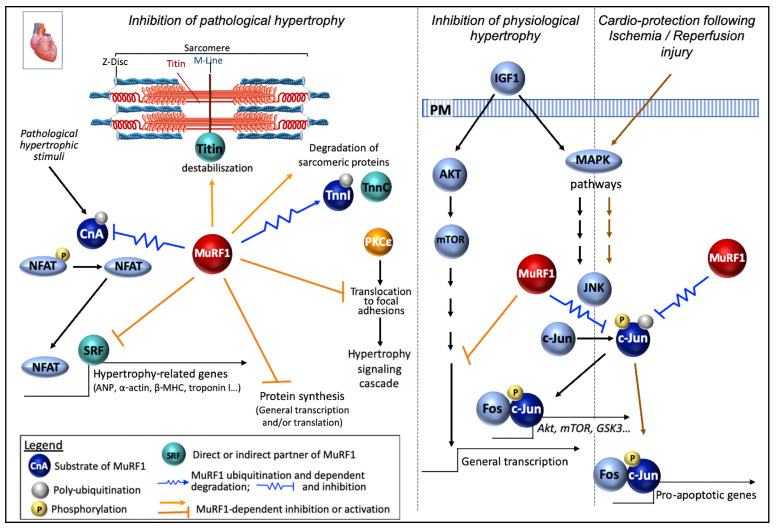Figure 4.
MuRF1 functions in cardiac muscle. MuRF1 exhibits a protective role in the heart by inhibiting pathological heart hypertrophy. Anti-hypertrophic function of MuRF1 can partly be explained by its atrophic function and the degradation of sarcomeric proteins like in skeletal muscle. Moreover, MuRF1 inhibits the protein synthesis of hypertrophy-related genes in response to hypertrophic stimuli, via the inhibition of at least three pathways (serum response factor (SRF), c-Jun N-terminal kinases (JNK), and AKT pathways). The activation of calcineurin/NFAT (nuclear factor of activated T cells) signaling alone is sufficient to induce pathological cardiac hypertrophy. MuRF1, by down-regulating the phosphatase CnA, prevents the translocation of the nuclear factor NFAT transcription from the cytosol to the nucleus and thus the consecutive transcription of hypertrophy-related genes. Moreover, MuRF1 mediates the inhibition of PKCε translocation to focal adhesions, a critical event in the hypertrophic signaling cascade. MuRF1 also limits physiological cardiac hypertrophy by inhibiting c-Jun protein expression and phosphorylation in the presence of insulin-like growth factor 1 (IGF-1). Another cardioprotective role of MuRF1 is to reduce cardiomyocytes apoptosis occurring after ischemia/reperfusion injury (I/R). During I/R, MuRF1 targets phospho-c-Jun for degradation, blocking the transcription of pro-apoptotic genes; it is noteworthy that the inhibition of JNK or c-Jun is cardioprotective in vivo. Act, alpha-actin; CnA, calcineurin A; IGF-1, insulin-like growth factor 1; MHC, myosin heavy chain; MLC, myosin light chain; MyBP-C, myosin binding prot-C; NFAT, nuclear factor of activated T cells; SRF, transcription factor serum response factor; TnnI, TnnC, troponin I and C.

